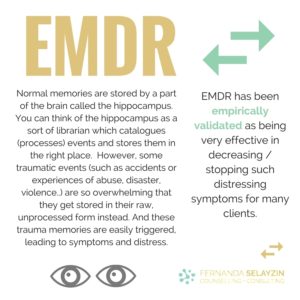EMDR
EMDR (Eye Movement Desensitization and Reprocessing) and Sensorimotor Psychotherapy are two of the most effective and safest approaches to treating the harmful effects of traumatic experiences including Post Traumatic Stress Disorder.
Both are trauma-focused, individual therapies which efficiently articulate elements from cognitive, behavioural, humanistic, body-based, psychodynamic, and contemplative therapies.
Yes, both are also somatic-oriented therapies (the holistic approach to therapy that takes into consideration the fact that trauma symptoms are the effects of instability of the autonomic nervous system – ANS).
In both approaches, and after proper stability and safety are established, clients are guided to be mindfully aware of the symptoms and memories of the trauma and their effects on the mind and body. As treatment progresses, symptoms decrease and disappear through a process of healing that safely bypasses the potential re-traumatization that less-sensitive talk-therapies unfortunately still often risk.
Affect Regulation & Bottom-up Psychotherapy
Affect regulation and emotional processes are highlighted as central to psychopathology and thus to psychotherapy practice. However, a direct, exclusive, or even primary focus on emotional processing may exacerbate dysregulation and/or reinforce maladaptive emotional patterns.
Affect may be best regulated, rather, through an exclusive focus on bottom-up or sensorimotor processing interventions that challenge these tendencies, promote stabilization, and pave the way for future efficacious processing of emotions.
And such sensorimotor processing interventions go beyond simple body awareness practices by making use of body sensation and movement to address and change how information is processed on a bodily level.
What about cases other than trauma? What about EMDR and Sensorimotor Psychotherapy for PERFORMANCE ENHANCEMENT?
Excellent question! Luckily these approaches to treatment are not exclusively effective for cases in which trauma has been experienced. In fact, one of the most innovative uses of such therapies – which are sometimes referred to as “third-wave cognitive therapies” – can be found in combining them with the best of what’s known today in neuroscience and positive psychology to support clients who are searching for ways to enhance their functioning and performance. Yes, clients such as professionals in need of meeting ever-increasing demands – from corporate executives to athletes and artistic performers – who may be interested in stepping up their game (or in recovering their confidence and peak performance after some experienced challenge, anxiety, or other setback). Yup! “What does not kill you…” thinking of Nietzsche here, btw. not Kanye 😉
What is EMDR?
Eye Movement Desensitization and Reprocessing is a psychotherapy approach designed for working with distressing or traumatic memories. The theory behind EMDR is that many psychological difficulties are the result of distressing life experiences which have not been stored in memory properly and are said to be unprocessed or blocked. These traumatic memories may need some help to become processed, and EMDR is one way to do this. More recently however, EMDR has also been used in cases where the goal was not to process memories so as to get rid of symptoms of trauma but to also enhance functioning and performance.
EMDR is a specific treatment protocol understood to stimulate both sides of the brain as the likely underlying mechanism of action to reprocess trauma and other complex memories. It is delivered by using bilateral stimulation (or dual attention stimulus) through eye movements, or bilateral (left/right) auditory or tactile stimulation when preferred.
Resources
Additional information on how EMDR works and about its most general applications (the “official” brochure from the EMDR International Association – EMDRIA)
General information about ATTACHMENT-FOCUSED EMDR (or EMDR for relational trauma) (Bilateral Stimulation for Resource Development).
… and for Performance Enhancement EMDR – one of the most innovative uses of EMDR
ESPAÑOL
Video Introducción a la EMDR para los clientes que prefieren comunicarse en español.
Sensorimotor Psychotherapy
Trauma and The Body
Healing from the past requires a delicate balance of stability, safety, and risk (in the sense of strengthening the courage to move forward.) Sensorimotor Psychotherapy is an approach that makes use of the body’s intelligence as a largely untapped resource in psychotherapy to support therapeutic change. And to safely process trauma without necessarily having to count exclusively on the client’s verbal narrative and its inherent risks of retraumatization. Instead, it draws on “somatic narratives” and the body as the carriers of traumatic burden and as powerful resources in healing. Sensorimotor interventions incorporate the body – through its uttered gestures, postures, prosodies, facial expressions, eye gaze, and movement – to unstuck clients from the past and to move towards a more satisfying and fulfilling life.
Regulation Theory & Interpersonal Neurobiology
What is the connection between your mind, your physical brain, your relationships, your body, and your health? The mind is both embodied and embedded (Daniel Siegel).
Clinical neurobiological models of therapeutic change are now focusing on the functions of the right brain, the body, and the autonomic nervous system. Finally.
Here is neuropsychologist Allan Schore on emotional regulation and interpersonal relationships.

